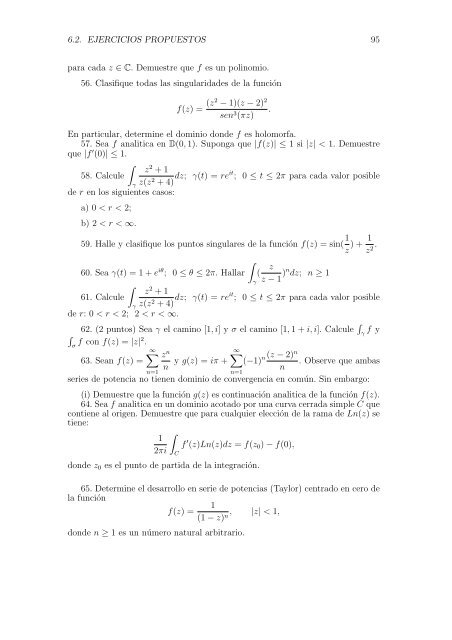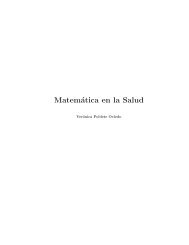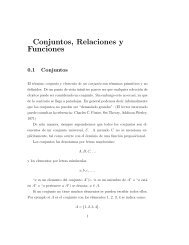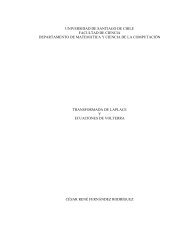Apuntes de Variable Compleja - Carlos Lizama homepage ...
Apuntes de Variable Compleja - Carlos Lizama homepage ...
Apuntes de Variable Compleja - Carlos Lizama homepage ...
Create successful ePaper yourself
Turn your PDF publications into a flip-book with our unique Google optimized e-Paper software.
6.2. EJERCICIOS PROPUESTOS 95<br />
para cada z ∈ C. Demuestre que f es un polinomio.<br />
56. Clasifique todas las singularida<strong>de</strong>s <strong>de</strong> la función<br />
f(z) = (z2 − 1)(z − 2) 2<br />
sen3 .<br />
(πz)<br />
En particular, <strong>de</strong>termine el dominio don<strong>de</strong> f es holomorfa.<br />
57. Sea f analitica en D(0, 1). Suponga que |f(z)| ≤ 1 si |z| < 1. Demuestre<br />
que |f ′ (0)| ≤ 1.<br />
<br />
z<br />
58. Calcule<br />
γ<br />
2 + 1<br />
z(z2 + 4) dz; γ(t) = reit ; 0 ≤ t ≤ 2π para cada valor posible<br />
<strong>de</strong> r en los siguientes casos:<br />
a) 0 < r < 2;<br />
b) 2 < r < ∞.<br />
59. Halle y clasifique los puntos singulares <strong>de</strong> la función f(z) = sin( 1 1<br />
) + .<br />
z z2 60. Sea γ(t) = 1 + eiθ <br />
z<br />
; 0 ≤ θ ≤ 2π. Hallar (<br />
γ z − 1 )ndz; n ≥ 1<br />
<br />
z<br />
61. Calcule<br />
γ<br />
2 + 1<br />
z(z2 + 4) dz; γ(t) = reit ; 0 ≤ t ≤ 2π para cada valor posible<br />
<strong>de</strong> r: 0 < r < 2; 2 < r < ∞.<br />
62. (2 puntos) Sea γ el camino [1, i] y σ el camino [1, 1 + i, i]. Calcule <br />
f y<br />
<br />
γ<br />
σ f con f(z) = |z|2 .<br />
∞ z<br />
63. Sean f(z) =<br />
n=1<br />
n<br />
∞<br />
n (z − 2)n<br />
y g(z) = iπ + (−1) . Observe que ambas<br />
n n<br />
n=1<br />
series <strong>de</strong> potencia no tienen dominio <strong>de</strong> convergencia en común. Sin embargo:<br />
(i) Demuestre que la función g(z) es continuación analitica <strong>de</strong> la función f(z).<br />
64. Sea f analitica en un dominio acotado por una curva cerrada simple C que<br />
contiene al origen. Demuestre que para cualquier elección <strong>de</strong> la rama <strong>de</strong> Ln(z) se<br />
tiene:<br />
<br />
1<br />
f<br />
2πi C<br />
′ (z)Ln(z)dz = f(z0) − f(0),<br />
don<strong>de</strong> z0 es el punto <strong>de</strong> partida <strong>de</strong> la integración.<br />
65. Determine el <strong>de</strong>sarrollo en serie <strong>de</strong> potencias (Taylor) centrado en cero <strong>de</strong><br />
la función<br />
1<br />
f(z) = ,<br />
(1 − z) n |z| < 1,<br />
don<strong>de</strong> n ≥ 1 es un número natural arbitrario.







